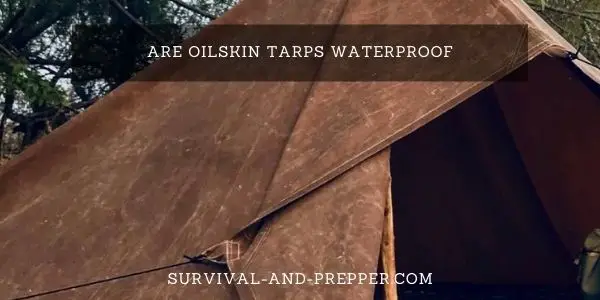Are Oilskin Tarps Waterproof?
Traditional Oilskin Tarps were created when sailors learned that their sails which had been accidentally soaked in oil repelled water. This process was repeated intentionally to recreate this waterproof characteristic. So yes, Oilskin or Oilcloth both in the traditional and more modern composition is waterproof.
What Makes Oilskin Waterproof
Oilskin is manufactured from very tightly woven fabrics, most often and traditionally a cotton or linen fabric of sorts. This fabric was then treated with various oils to create the waterproofing effect.
As the oils are absorbed into the fibers of the woven fabric, the cotton material absorbs it and swells up. This swelling further increases the tightness of the weave and makes it more difficult for water to penetrate the fabric.
The tight weave along with the nature of oil to resist combining with water result in a fabric that is almost completely waterproof in many cases.
You may have observed this characteristic of oil when you see water bead up on a roadway instead of soaking into the pavement. This beading is a result of the oil having waterproofed that particular area.
What Oil is Used To Make Oilskin Fabric Waterproof
While it may seem like any oil could work to make oilskin or oil cloth, this is not the case. You can check out this article on How to Make Oilcloth to learn more about what effects various oils may have on your cloth.
However, for now let it suffice that the original oilcloth was made by using a mixture of Boiled Linseed Oil and Turpentine or Mineral spirits. This mixture provided the benefits of the oil while encouraging proper drying so that the fabric did not remain oily in texture.
Modern oilcloth on the other hand is still manufactured from a cotton or linen fabric, but it is instead coated with a petroleum based finish such as “polyvinyl chloride”. You have likely seen this in some form on those cheap plastic feeling tablecloths you can purchase in stores.
Modern Uses of Oilcloth as a Waterproof Fabric
While no longer used as sails, oilcloth or oilskin can still find uses. Due to the pliable and waterproof nature of oilskin it is often used for hats and boots where a waterproof effect is desired.
Additionally it finds many of its main uses as tarps both for bushcrafters and hobbyists who need a waterproof tarp to cover their boats, RVs and cars or a waterproof tarp for camping.
Being made from cotton and linen fabrics it tends to be somewhat safer as a cover on delicate finishes and can still be found being used as a tablecloth in some instances.
While oilcloth is waterproof and makes an excellent tarp, you should probably consider another material if you are wanting to make a walled tent. The somewhat flammable nature of true oilskin makes it less than ideal for this purpose.
Conclusion
Oilskin tarps in both their traditional linseed oil form and modern PVC form are waterproof. Oilskin tarps can be used to cover tents, shelters, picnic tables and even vehicles to provide a rain proof cover.
You can also find oilskin marketed as Oilcloth, these materials are actually the same. However, they differ somewhat from waxed cotton in which they are often associated with. While you are here check out the differences between oilcloth and waxed cotton fabrics.






